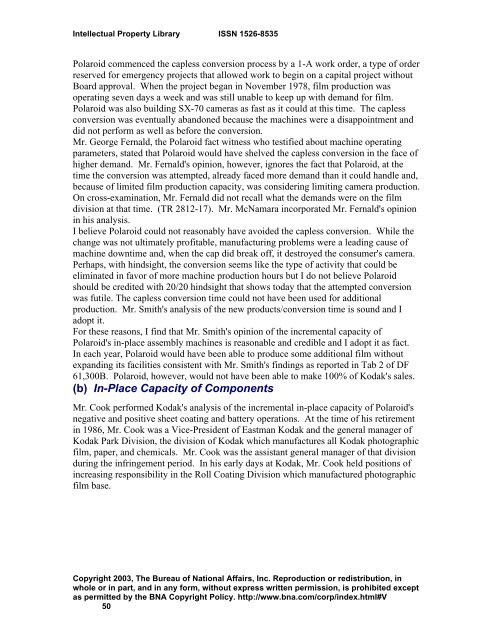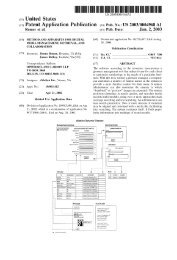Polaroid Corp. v. Eastman Kodak Co. - Oppedahl Patent Law Firm LLC
Polaroid Corp. v. Eastman Kodak Co. - Oppedahl Patent Law Firm LLC
Polaroid Corp. v. Eastman Kodak Co. - Oppedahl Patent Law Firm LLC
Create successful ePaper yourself
Turn your PDF publications into a flip-book with our unique Google optimized e-Paper software.
Intellectual Property Library ISSN 1526-8535<br />
<strong>Polaroid</strong> commenced the capless conversion process by a 1-A work order, a type of order<br />
reserved for emergency projects that allowed work to begin on a capital project without<br />
Board approval. When the project began in November 1978, film production was<br />
operating seven days a week and was still unable to keep up with demand for film.<br />
<strong>Polaroid</strong> was also building SX-70 cameras as fast as it could at this time. The capless<br />
conversion was eventually abandoned because the machines were a disappointment and<br />
did not perform as well as before the conversion.<br />
Mr. George Fernald, the <strong>Polaroid</strong> fact witness who testified about machine operating<br />
parameters, stated that <strong>Polaroid</strong> would have shelved the capless conversion in the face of<br />
higher demand. Mr. Fernald's opinion, however, ignores the fact that <strong>Polaroid</strong>, at the<br />
time the conversion was attempted, already faced more demand than it could handle and,<br />
because of limited film production capacity, was considering limiting camera production.<br />
On cross-examination, Mr. Fernald did not recall what the demands were on the film<br />
division at that time. (TR 2812-17). Mr. McNamara incorporated Mr. Fernald's opinion<br />
in his analysis.<br />
I believe <strong>Polaroid</strong> could not reasonably have avoided the capless conversion. While the<br />
change was not ultimately profitable, manufacturing problems were a leading cause of<br />
machine downtime and, when the cap did break off, it destroyed the consumer's camera.<br />
Perhaps, with hindsight, the conversion seems like the type of activity that could be<br />
eliminated in favor of more machine production hours but I do not believe <strong>Polaroid</strong><br />
should be credited with 20/20 hindsight that shows today that the attempted conversion<br />
was futile. The capless conversion time could not have been used for additional<br />
production. Mr. Smith's analysis of the new products/conversion time is sound and I<br />
adopt it.<br />
For these reasons, I find that Mr. Smith's opinion of the incremental capacity of<br />
<strong>Polaroid</strong>'s in-place assembly machines is reasonable and credible and I adopt it as fact.<br />
In each year, <strong>Polaroid</strong> would have been able to produce some additional film without<br />
expanding its facilities consistent with Mr. Smith's findings as reported in Tab 2 of DF<br />
61,300B. <strong>Polaroid</strong>, however, would not have been able to make 100% of <strong>Kodak</strong>'s sales.<br />
(b) In-Place Capacity of <strong>Co</strong>mponents<br />
Mr. <strong>Co</strong>ok performed <strong>Kodak</strong>'s analysis of the incremental in-place capacity of <strong>Polaroid</strong>'s<br />
negative and positive sheet coating and battery operations. At the time of his retirement<br />
in 1986, Mr. <strong>Co</strong>ok was a Vice-President of <strong>Eastman</strong> <strong>Kodak</strong> and the general manager of<br />
<strong>Kodak</strong> Park Division, the division of <strong>Kodak</strong> which manufactures all <strong>Kodak</strong> photographic<br />
film, paper, and chemicals. Mr. <strong>Co</strong>ok was the assistant general manager of that division<br />
during the infringement period. In his early days at <strong>Kodak</strong>, Mr. <strong>Co</strong>ok held positions of<br />
increasing responsibility in the Roll <strong>Co</strong>ating Division which manufactured photographic<br />
film base.<br />
<strong>Co</strong>pyright 2003, The Bureau of National Affairs, Inc. Reproduction or redistribution, in<br />
whole or in part, and in any form, without express written permission, is prohibited except<br />
as permitted by the BNA <strong>Co</strong>pyright Policy. http://www.bna.com/corp/index.html#V<br />
50





